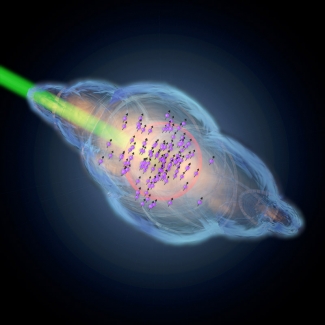The Ye and Rey groups have discovered the strange rules of quantum baseball in which strontium (Sr) atoms are the players, and photons of light are the balls. The balls control the players by not only getting the atoms excited, but also working together. The players coordinate throwing and catching the balls. While this is going on, the balls can change the state of the players! Sometimes the balls even escape the quantum baseball game altogether and land on detectors in the laboratory. The rate at which these balls are detected provides information about the state of the players. This kind of communication between atoms and photons in three-dimensional (3D) quantum matter is going to have important application to a variety of quantum systems, including optical atomic clocks.
“Players communicate with each other by exchanging balls,” said Ye. “Depending on the incidence of the balls with respect to a particular player lineup, all the players can start to act together and throw their balls in the same direction. ”
And, Rey says there is almost never just a single pass before a ball escapes. Rather, a ball is passed many times between the players. This process coordinates the movements of the players and provides information about their states. Plus, the closer players are to each other, the faster the balls get thrown between them. The fast pace of the quantum baseball game enhances the probability that balls escape.
Quantum baseball is essentially a novel form of interatomic communication in which photons simultaneously carry forces that influence the atomic responses and information about those atomic responses. All of this action is transmitted throughout a cloud of hundreds or thousands of atoms.
“Usually, atoms talk to each other by knocking into each other, in other words via collisions,” said Ye. “But a simple calculation shows that communication via collisions was not what we were observing with spectroscopy in our lab.”
The Ye group’s observation remained a mystery until French scientist Robin Kaiser visited JILA and championed the idea that collective communication in an atom cloud could result from the sharing of photons.
Soon, theorists Ana Maria Rey, graduate student Bihui Zhu, and colleagues from Harvard discovered that the collective atom-photon interactions could be responsible for the enhanced emission rate measured by laboratory detectors. So graduate student Sarah Bromley and the Ye group’s experimental team studied the quantum baseball-like behavior of photons and Sr atoms by using two lasers: a high-energy blue laser (that made the atoms very energetic and throw balls very fast) and a lower-energy red laser (that made the atoms less energetic and throw balls at a much slower rate).
The red laser tracked the motion of the Sr atoms. In contrast, the blue laser “froze out” the motion of the atoms because the atom-photon (player-ball) exchange happens so fast. Together, the two lasers discovered the rules of quantum baseball in the microscopic quantum world.
The researchers responsible for this productive theory-experiment collaboration include graduate students Sarah Bromley, Bihui Zhu, and Tobias Bothwell, research associates Xibo Zhang and Johannes Schachenmayer, former graduate students Mike Bishof and Travis Nicholson, Fellows Ana Maria Rey and Jun Ye, Mikhail Lukin and Susanne Yelin of Harvard, as well as colleagues from the Université de Nice Sophia Antipolis (France) and the University of Connecticut.––Julie Phillips




